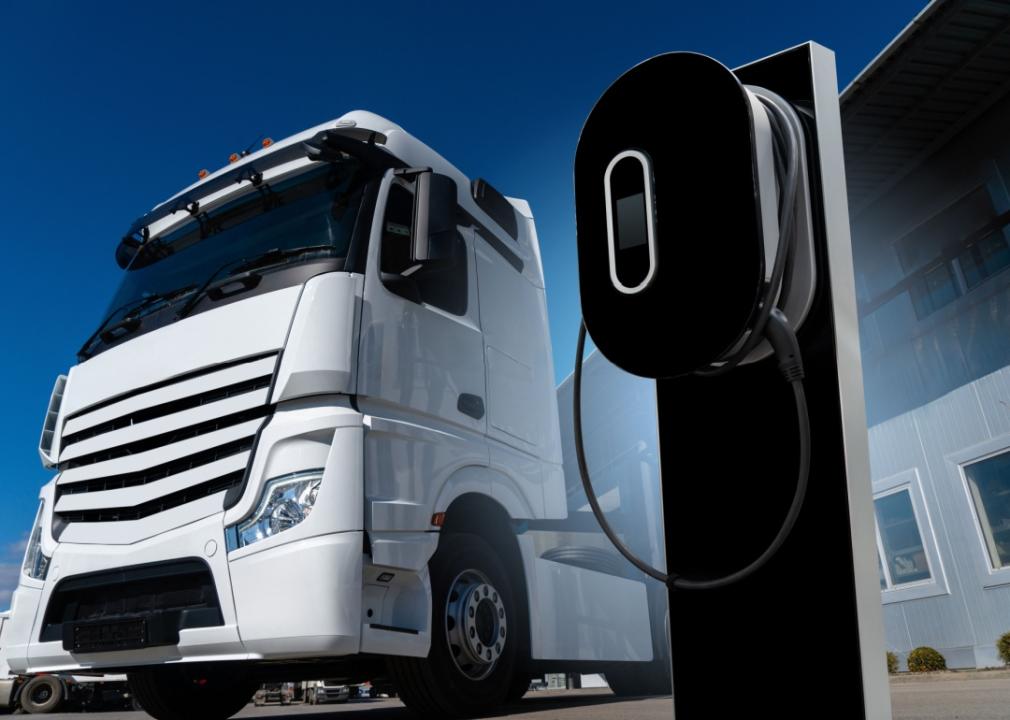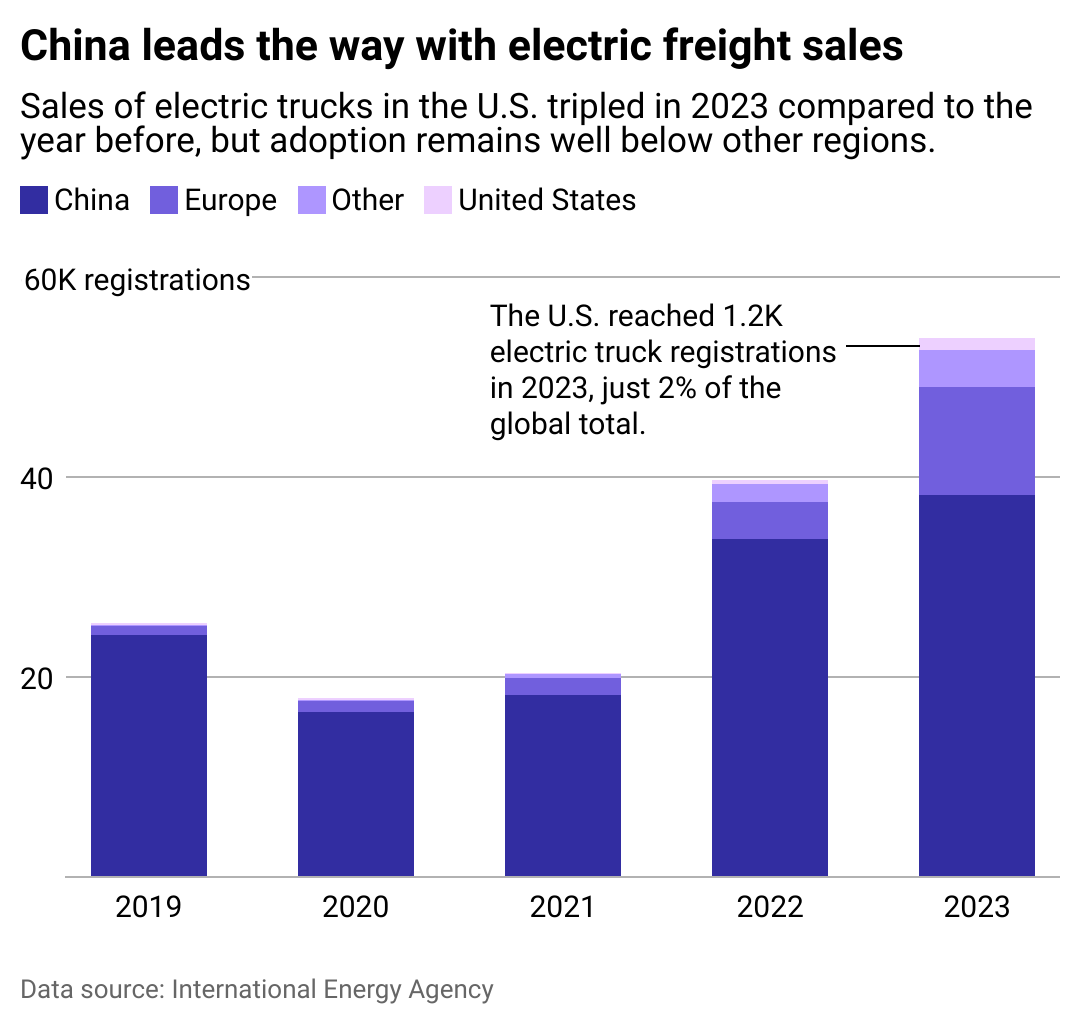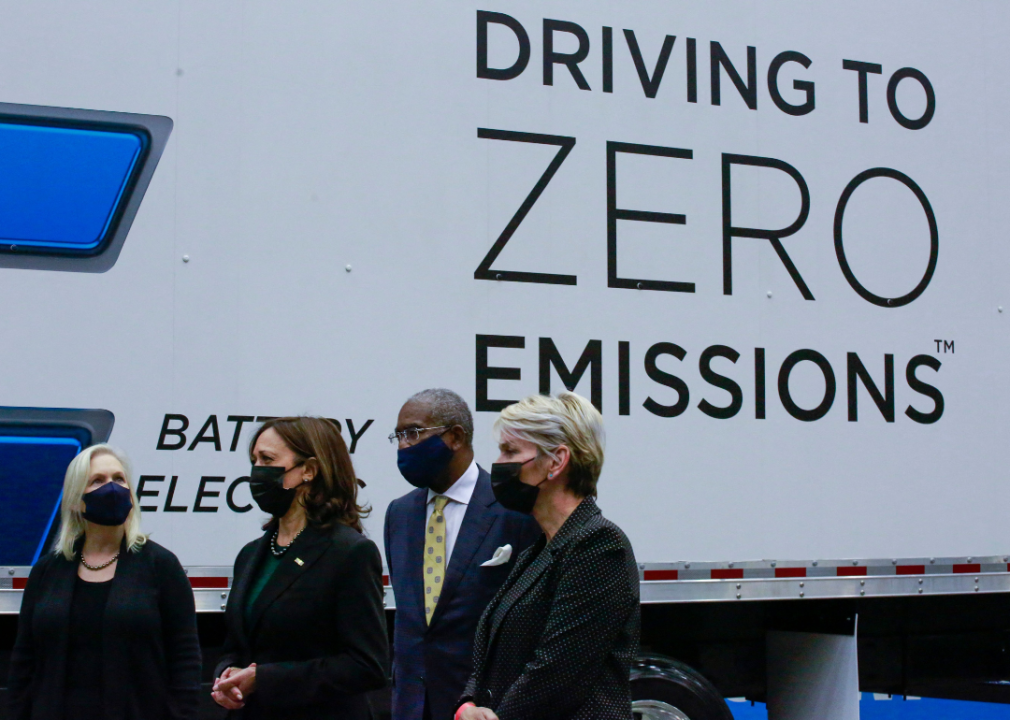A closer look at how heavy electric trucks are gaining a foothold in the US transportation industry—and how we got here

Scharfsinn // Shutterstock
A closer look at how heavy electric trucks are gaining a foothold in the US transportation industry—and how we got here
An electric freight truck at a charger.
As cities worldwide implement zero-emission zones for freight, transportation businesses and local authorities have increasingly looked for ways to electrify heavy-duty vehicles.
Global sales of heavy-duty electric trucks between 2022-2023 climbed by more than one-third, according to the International Energy Agency. The United States occupied just 0.1% of the 54,000 total reported global sales in 2022. Truck Parking Club looked at the growing adoption of heavy electric trucks in the U.S. and compared that growth with other countries embracing medium- and heavy-duty electric freight trucks. Historical data comes from the International Energy Agency.
Heavy-electric truck adoption in the U.S. is growing, albeit slowly. Charging infrastructure rollout is lagging, truck-model recalls slowed market launches, and two battery makers—Romeo Power and Proterra—liquidated assets and entered Chapter 11 bankruptcy, respectively.
China leads the electric truck market, comprising 70% of 2023 sales worldwide, according to the IEA, marking a sharp decrease from the 85% it occupied in 2022. European Union countries saw a significant increase in electric truck purchases, tripling sales in just a year. Growth was similar in the United States, although total sales lagged behind at 1,200.
In the U.S., the electric trucking industry didn’t begin to really catch on until 2019, when German-based manufacturer Daimler shipped its electric Freightliner semi-truck. In 2022, smaller delivery trucks manufactured by EV startup Rivian began hitting the pavement as part of Amazon’s fleet.
That same year, Tesla launched the first electric Class 8 semi-truck outside of its warehouse in Sparks, Nevada, giving the U.S. a stake in the global market. The futuristic Tesla Semi promised a longer range, safer braking, and a better driving experience. By 2023, other manufacturers followed suit with their own hulking Class 8 electric semis, including Volvo’s VNR Electric.
Electric trucks are still relatively uncommon on the road. As of January 2024, of a fleet of 12.2 million trucks, just 13,000 were electric, according to the Environmental Defense Fund analysis. That analysis defined these trucks as Class 2B to Class 8 vehicles, ranging from step-up vans to tractor-trailers.
Tesla and Daimler will remain industry leaders in 2024 as electric trucks continue to gain momentum, notably because of their cost-effectiveness compared to diesel trucks. The lower cost of electricity compared to fossil fuels, stable electricity rates, and simpler drivetrains or transmission systems all contribute to the price difference. Additionally, electric trucks designed with batteries and motors at the bottom provide a lower center of gravity, enhancing stability and reducing rollover risk, according to EESI.
Electric trucks are not without their disadvantages, however. High initial costs and uneven charging infrastructure raise significant questions about the long-term payoff of the investment.
Even as battery technology for electric trucks continues to evolve, manufacturers will face formidable challenges on the path to widespread adoption.
Despite the potential to increase the range of electric trucks by 30%, the large size and hefty weight of Daimler Trucks’ lithium iron phosphate batteries—plus their lower energy density and poor performance in extreme temperatures—make them less than ideal for cross-country treks in varied conditions. Nissan projects exclusive use of lighter-density solid-state batteries by 2028; but drawbacks remain, including the high price of lithium, a lack of viable recycling options, and the risks of lithium electrodes shorting out as batteries age.
The push for greener freight remains strong despite obstacles. Organizations in the U.S.—notably the North American Council for Freight Efficiency and the Rocky Mountain Institute—are working to identify elements of the trucking industry that could be electrified by conducting trials. So far, they’ve deployed nearly 300 electric trucks of different sizes to collect data on their performance and challenges in the market.
Proponents of the technology argue that electric HDVs emit significantly lower greenhouse gases than their conventional counterparts, making them a powerful tool in the fight against climate change. The potential public health benefits would be worth hundreds of billions of dollars, according to the Environmental and Energy Study Institute.
![]()

Truck Parking Club
How the rest of the world is investing in EV technology
A bar chart showing how China leads the way with electric freight sales compared to other countries, including European countries and the U.S. The U.S. reached 1,200 electric truck registrations in 2023, just 2% of the global total.
As a manufacturer of goods exported worldwide, China dominates the electric truck market in part due to its large customer base and high demand for such vehicles.
This is particularly the case in light of recent Chinese government policymaking, which zeroes in on commercial vehicles like freight trucks as part of the country’s overall electrification strategy, according to the International Council on Clean Transportation.
China has aimed to incentivize greater electric truck use by supporting battery-swapping technology. At charging stations, drivers can replace their battery with a fully charged one in minutes rather than waiting up to several hours to charge their vehicle.
Roughly half of electric trucks in China had swappable batteries in 2020, according to the council. Technologies such as battery-swapping significantly alleviate range anxiety—a barrier to electrifying—by delivering an experience similar to fueling at a gas station.
European regulators have also attempted to nudge the HDV industry toward electrification through strict regulations. In April 2024, the European Parliament overwhelmingly voted to require CO2 emissions from large trucks and buses to be slashed incrementally from 2030, reaching a 90% reduction in emissions by 2040. Europe is home to many electric vehicle manufacturers, and these regulations could bring similar changes to other jurisdictions where European-built HDVs are sold.

KENA BETANCUR/AFP // Getty Images
How the US is investing in electric freight adoption
Senator Kirsten Gillibrand, Vice President Kamala Harris, Representative Gregory Meeks, and Secretary of Energy Jennifer Granholm, standing next to a heavy-duty electric truck with the words, driving to zero emissions.
HDVs aren’t the only mode of transportation undergoing electrification. Under the Biden administration, the U.S. is promoting EV freight adoption through the National Zero-Emission Freight Corridor Strategy. This long-term plan aims to broaden the zero-emission vehicle charging and hydrogen fueling infrastructure along approximately 12,000 miles of major freight routes nationwide.
At the state level, at least 17 states and Washington D.C. agreed to an action plan to work toward 100% electric medium and heavy-duty vehicle sales by 2050. The Joint Office of Energy and Transportation and the Department of Energy developed the strategy with the Department of Transportation and the Environmental Protection Agency.
Disparities in charging infrastructure in rural areas remain a significant barrier to electrification. Another common concern in the passenger vehicle market is charging time, which could impact truckers operating on tight schedules. This, however, can be mitigated by improving charging technology and exploring the use of China’s battery swap technology in the American market.
Story editing and additional writing by Alizah Salario. Copy editing by Kristen Wegrzyn.
This story originally appeared on Truck Parking Club and was produced and
distributed in partnership with Stacker Studio.